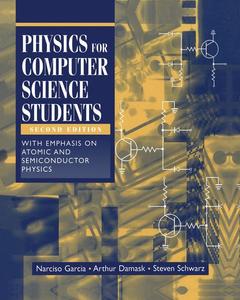Physics for Computer Science Students (2nd Ed., 2nd ed. 1998. Softcover reprint of the original 2nd ed. 1998) With Emphasis on Atomic and Semiconductor Physics

Presents many of the topics of a standard introductory physics course in the first section of the book, but with the selection tailored to be of use in the second half, which develops the physics of semiconductor devices * Incorporates updated material regarding electronic devices * Includes new chapter on integrated circuits and heterostructures
Date de parution : 10-2012
Ouvrage de 560 p.
20.3x25.4 cm
Disponible chez l'éditeur (délai d'approvisionnement : 15 jours).
Prix indicatif 58,01 €
Ajouter au panierMots-clés :
CCD; MOSFET; Potential; circuit; computer; electromagnetic wave; electronics; electrostatics; energy; integrated circuit; logic; manufacturing; mechanics; programming; quantum mechanics



